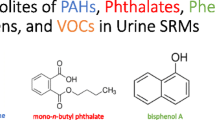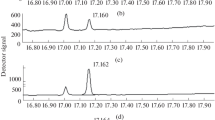Abstract
In a previous study, we found that appreciable amounts of ethylene glycol (EG), propylene glycol (PG), and diethylene glycol (DEG) were present in the blood of nonoccupational healthy humans. In this study, we measured the three glycols in the urine of healthy subjects by the same isotope dilution gas chromatography–mass spectrometry method, and found the concentrations to be much higher than those in blood. The concentrations of EG, PG, and DEG in urine samples (mean ± standard deviation) obtained from 23 subjects at random were 604 ± 360, 5,450 ± 9,290, and 59.0 ± 49.3 ng/ml, respectively. These values were 9.44, 30.1, and 5.31 times higher than those in whole blood samples, respectively. The much higher concentrations of the three glycols found in urine samples of nonoccupational healthy humans suggest that the three glycols, once incorporated into the human body, are rapidly excreted into urine. To our knowledge, this is the first demonstration of the presence of relatively high concentrations of EG, PG, and DEG in urine of healthy human subjects.


Similar content being viewed by others
References
Baselt RC (2004) Disposition of toxic drugs and chemicals in man, 7th edn. Biomedical Publications, Foster, pp 332–333, 425–428, 960–961
Wurita A, Suzuki O, Hasegawa K, Gonmori K, Minakata K, Yamagishi I, Nozawa H, Watanabe K (2013) Sensitive determination of ethylene glycol, propylene glycol and diethylene glycol in human whole blood by isotope dilution gas chromatography–mass spectrometry, and the presence of appreciable amounts of the glycols in blood of healthy subjects. Forensic Toxicol 31:272–280
Porter WH, Rutter PW, Yao HH (1999) Simultaneous determination of ethylene glycol and glycolic acid in serum by gas chromatography–mass spectrometry. J Anal Toxicol 23:591–597
Maurer HH, Peters FT, Paul LD, Kraemer T (2001) Validated gas chromatographic–mass spectrometric assay for determination of antifreezes ethylene glycol and diethylene glycol in human plasma after microwave-assisted pivalylation. J Chromatogr B 754:401–409
Rasanen I, Viinamäki J, Vuori E, Ojanperä I (2010) Headspace in-tube extraction gas chromatography–mass spectrometry for the analysis of hydroxylic methyl-derivatized and volatile organic compounds in blood and urine. J Anal Toxicol 34:113–121
Gembus V, Goullé J-P, Lacroix C (2002) Determination of glycols in biological specimens by gas chromatography–mass spectrometry. J Anal Toxicol 26:280–285
Van Hee P, Neels H, De Doncker M, Vrydags N, Schattemann K, Uyttenbroeck W, Hamers N, Himpe D, Lambert W (2004) Analysis of γ-hydroxybutyric acid, DL-lactic acid, glycolic acid, ethylene glycol and other glycols in body fluids by a direct injection gas chromatography–mass spectrometry assay for wide use. Clin Chem Lab Med 42:1341–1345
Meyer MR, Weber AA, Maurer HH (2011) A validated GC–MS procedure for fast, simple, and cost-effective quantification of glycols and GHB in human plasma and their identification in urine and plasma developed for emergency toxicology. Anal Bioanal Chem 400:411–414
Pietracci E, Bermejo A-M, Álvarez I, Cabarcos P, Balduini W, Tabernero M-J (2013) Simultaneous determination of new-generation antidepressants in plasma by gas chromatography–mass spectrometry. Forensic Toxicol 31:124–132
Nakazono Y, Tsujikawa K, Kuwayama K, Kanamori T, Iwata YT, Miyamoto K, Kasuya F, Inoue H (2013) Differentiation of regioisomeric fluoroamphetamine analogs by gas chromatography–mass spectrometry and liquid chromatography–tandem mass spectrometry. Forensic Toxicol 31:241–250
Shima N, Katagi M, Kamata H, Matsuta S, Nakanishi K, Zaitsu K, Kamata T, Nishioka H, Miki A, Tatsuno M, Sato T, Tsuchihashi H, Suzuki K (2013) Urinary excretion and metabolism of the newly encountered designer drug 3,4-dimethylmethcathinone in humans. Forensic Toxicol 31:101–112
Zaitsu K, Miyagawa H, Sakamoto Y, Matsuta S, Tsuboi K, Nishioka H, Katagi M, Sato T, Tatsuno M, Tsuchihashi H, Suzuki K, Ishii A (2013) Mass spectrometric differentiation of the isomers of mono-methoxyethylamphetamines and mono-methoxydimethylamphetamines by GC–EI–MS–MS. Forensic Toxicol 31:292–300
Conflict of interest
There are no financial or other relations that could lead to a conflict of interest.
Author information
Authors and Affiliations
Corresponding author
Rights and permissions
About this article
Cite this article
Wurita, A., Suzuki, O., Hasegawa, K. et al. Presence of appreciable amounts of ethylene glycol, propylene glycol, and diethylene glycol in human urine of healthy subjects. Forensic Toxicol 32, 39–44 (2014). https://doi.org/10.1007/s11419-013-0206-5
Received:
Accepted:
Published:
Issue Date:
DOI: https://doi.org/10.1007/s11419-013-0206-5




